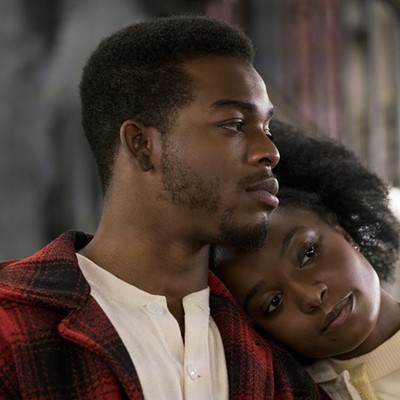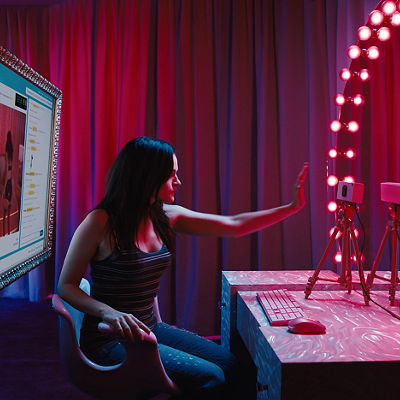The man who gave us Young Darth returns with a Young Indy boxed set.
Rick McCallum had nothing to do with the original Star Wars. He was just 23 years old and chasing his first job in the film industry when it was released in 1977. "I'm portrayed as 70 years old on the Internet because somebody thinks that I did the original Star Wars," he says. In fact, McCallum didn't receive his first screen credit until fours later, when he produced Herb Ross's somber 1981 adaptation of Dennis Potter's The Singing Detective, in which sheet-music salesman Steve Martin lip-synched to Depression-era hits by the likes of Fred Astaire and Bing Crosby — a far, far cry from a galaxy far, far away.
But in recent years, McCallum has become as inextricably linked to George Lucas's franchise as Lucas himself. McCallum produced the Anakin Skywalker trilogy and oversaw the mid-1990s redos of the original films, the so-called special editions. You know, the Star Wars in which Greedo shoots first. "There was a lot of controversy when the special edition came out, from hardcore fans," McCallum says, chuckling. "But that was the film George wanted to make."
McCallum has been Lucas's right-hand man — or, in a joke that only Star Wars fetishists will appreciate, right hand — since 1990, when Lucas hired him to oversee production of The Young Indiana Jones Chronicles for ABC, volume one of which finally sees release on DVD this week. (The show will be issued piecemeal in two more boxed sets in coming months.) The series, which told Indy's origin story, seemed initially like an obvious winner, coming a year after Lucas and Steven Spielberg wrapped what they believed to be the final installment of the movie trilogy starring Harrison Ford. River Phoenix appears as a young Henry Jones Jr. at the beginning of Indiana Jones and the Last Crusade, and Lucas wanted to revisit Young Indy — at both 10 (with actor Corey Carrier) and 17 (Sean Patrick Flanery) — and use the show as a prime-time history lesson. Among the "characters" making cameos: Al Capone, Sigmund Freud, John Ford, George Patton, Sidney Bechet, and just about every other influential figure of the early 20th century.
Ultimately, McCallum would lead the production to 35 countries, hire a cast of bit players destined for bigger things (among them Catherine Zeta-Jones, Daniel Craig, Geoffrey Wright, and Elizabeth Hurley) and spend millions on a series that won 10 Emmy Awards during its run from 1992 to 1994. But ABC washed its hands of the show, and unaired episodes ran on the USA Network in the mid-'90s. The show disappeared, one more relic in need of unearthing by an archeologist sporting a fedora.
"Even though we had always told ABC we weren't making an Indiana Jones film or a TV series that echoed an action-packed film, they just never got it," McCallum says now. "We had a really loyal base, but ABC, after the first two episodes, they moved it six or seven times. It was always meant for Sunday evening, an 8 o'clock show, where a family could sit down and watch it together. But that concept was slowly being bled out of America. The concept of a family watching anything together was almost an alien concept by then."
There were practical reasons for the delay of the Young Indy boxed set. Foremost, the producers were distracted by that other franchise, about some kid who becomes Darth Vader. And once it was announced there'd be a fourth Indy film — Indiana Jones and the Kingdom of the Crystal Skull, to open next Memorial Day — Lucasfilm considered putting off the DVD release.
But the boxed set is also like no other DVD collection: Each episode — 44 were made, and they've been repackaged into 22 two-hour "movies" — is accompanied by a bunch of newly minted documentaries, ranging in subject from "Theodore Roosevelt and the American Century" to "Powder Keg — Europe 1900 to 1914" to "Jiddu Krishnamurti — The Reluctant Messiah." There are 94 documentaries in all, each overseen by David Schneider of CBS News, as well as an interactive timeline covering the span of the series and a lecture from University of Texas history professor H.W. Brands on America's expansion during the 20th century. So much for navel-gazing commentaries and behind-the-scenes peaks, which are thankfully absent.
"We realized, if we have any shot at all of getting the Young Indy box out, it couldn't be associated with Indy 4, and that it'd have to come before," McCallum says. "Paramount knew there'd be an enormous amount of interest in Indy. So we started working on it, and originally we were only going to do, like, 30 or 40 documentaries, but George got more and more ambitious. Plus, we had a great team, and they just started coming out so well, so we just said, 'Oh, fuck it. These are the characters we've always wanted to do.' And that's what we did, and it got up to 94."
Despite the ABC fiasco, McCallum and Lucas will bring a live-action Star Wars series to network TV, they hope, sometime in 2009, without a Skywalker in sight. And, yes, absolutely, Lucas and McCallum used Young Indy as a template for Young Darth — from the way the TV series and second trilogy were financed (wholly by Lucasfilm) to revisiting a beloved franchise from a child's perspective.
"The risk was all ours," McCallum says, referring to both Young Indy and Star Wars Episode I: The Phantom Menace, which introduced Darth Vader as an 8-year-old would-be messiah. "The company would live or die on that risk. We thought it was a pretty safe risk with Star Wars because we thought all we had to do was ... tell the story of Darth Vader. But that isn't the story that George had written, and he wasn't interested in it. He wasn't interested in doing a story for kids who had seen the film who were now in their late 30s and 40s. He was interested about kids who were 8 to 12 years old. He was making it for a new generation altogether. It's very interesting. Most older fans hate the prequels — well, it's not that they hate them, but they say they're too slow, there's not enough action, the explosions are corny.
"But if you're an 8-year-old kid and you see an 8-year-old kid flying a pod racer, it does something to you. It's a totally different impact. It's like Jar Jar Binks. He was the most hated thing [by the original trilogy's fans], but he's the second-most-popular character in our merchandising."
McCallum is told: You're kidding.
He laughs.
"No, because if you're a goofy kid and you're breaking out with pimples and everything else, Jar Jar's your guy," he says. "It's just weird. And I'm not defensive about it at all because I actually understand both sides of it completely, but it is interesting how it played out. What makes George and Steven Spielberg unique as filmmakers — George as a storyteller and Steven as a filmmaker — is that they're always looking at the world from the point of view of an 8- to 12-year-old boy. The camera's always set low and looking up. And it's always about wonderment."
Rick McCallum|George Lucas|Star Wars|Indiana Jones





